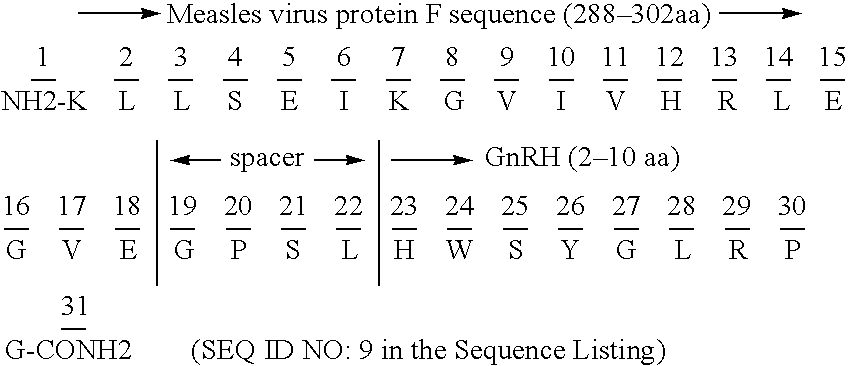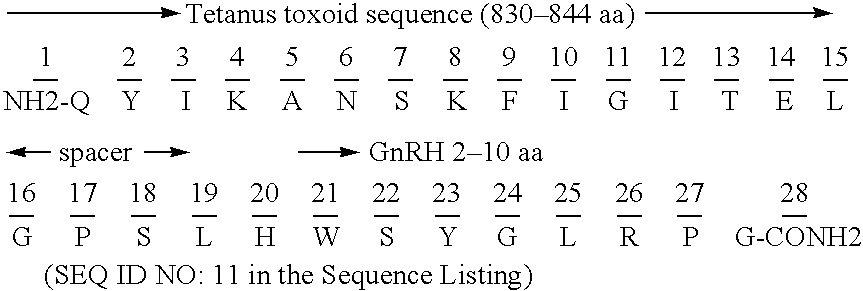Chimeric peptide immunogens
a technology of chimeric peptides and immunogens, which is applied in the field of chimeric peptides, can solve the problems of not being regarded promiscuous enough to be applicable for a large number, and limited different forms, and achieve the effect of suppressing an antibody respons
- Summary
- Abstract
- Description
- Claims
- Application Information
AI Technical Summary
Benefits of technology
Problems solved by technology
Method used
Image
Examples
example i
GnRH Chimeric Immunogens
[0071] The peptide sequences combine a select promiscuous T-helper-epitope through an inserted short spacer peptide (e.g., 4-8 amino acids) with at least one target hormone peptide. Suitable spacers of this invention include but are not limited to the peptides comprising the following amino acid sequence, GPSL (see SEQ ID NO: 5); SSGPSL (SEQ ID NO: 6); and SSGPSLKL (SEQ ID NO: 7), which are inserted in the peptide chimera to isolate the three dimensional folding of the immunogenic peptide from that of the hormone peptide.
[0072] Promiscuous Th-epitope moieties from measles virus protein F (MSF) (sequence 288-302 aa, SEQ ID NO: 8), tetanus toxoid (TT) (sequence 947-967 aa, SEQ ID NO: 4, or sequence 830-844 aa, SEQ ID NO: 2) and malaria Plasmodium falciparum CSP protein (sequence 378-398 aa, SEQ ID NO: 3) are used in these constructs. The hormone immunomimic epitopes were attached to the N-terminal or the C-terminus of the spacer as shown below. All mammalian ...
example ii
Immunogenicity of Chimeric Immunogens
[0089] Immunogenicity tests were performed with five chimeric peptide immunogens against GnRH. Each chimeric peptide contained one region encoding an epitope to be recognized by helper T-cell and a second region encoding an immunomimic of GnRH, to serve as the target for the antibody response. The chimeric peptide immunogens were formulated to deliver 100, 250 or 500 μg doses of peptide with 3 μg norMDP, in a water in oil emulsion. Control immunogens were prepared to deliver 500 μg of mammalian GnRH (1-10) Ser1 peptide (which is normally linked to an immunogenic carrier to impart immunogenicity), with and without norMDP (3 μg), in the same emulsions. The immunogens were given intramuscularly to rabbits in three injections, on days 0, 14 and 42. An ELISA procedure was used to measure the resultant anti-GnRH antibody responses in sera collected at 14-day intervals over the course of the immunization. Injection site reactions were assessed by visua...
example iii
Modulated Antibody Response By Mixtures of Chimeric Immunogens
[0110] The chimeric peptide immunogens were formulated in Montanide ISA 703 with 3 μg of norMDP singly (500 μg dose) or as mixtures of three chimeric immunogens, including chimeric immunogens 2 and 3 (600 μg dose total peptide). One formulation of all six peptides in a single mixture was also prepared (600 μg total dose). See Table 5.
[0111] The six GnRH chimeric immunogens tested were selected from the GnRH chimeric peptides 1-16. The materials used in the immunogenicity tests are shown below, including the sequences of the GnRH Chimeric Immunogens (the TT epitope in parenthesis and the GnRH epitope underlined.) [0112] 1. GnRH chimeric immunogen 2 {TT-3 (Tetanus Toxoid Epitope 3)} (MW 3886.5) [0113] 2. GnRH chimeric immunogen 3 {TT-2 (Tetanus Toxoid Epitope 2)} (MW 3132.6) [0114] 3. GnRH chimeric immunogen 13 (Tetanus Toxoid Epitope 10) (MW 3771.1) [0115] 4. GnRH chimeric immunogen 14 (Tetanus Toxoid Epitope 11) (MW 378...
PUM
| Property | Measurement | Unit |
|---|---|---|
| Immunogenicity | aaaaa | aaaaa |
| Antigenicity | aaaaa | aaaaa |
Abstract
Description
Claims
Application Information
 Login to View More
Login to View More - R&D
- Intellectual Property
- Life Sciences
- Materials
- Tech Scout
- Unparalleled Data Quality
- Higher Quality Content
- 60% Fewer Hallucinations
Browse by: Latest US Patents, China's latest patents, Technical Efficacy Thesaurus, Application Domain, Technology Topic, Popular Technical Reports.
© 2025 PatSnap. All rights reserved.Legal|Privacy policy|Modern Slavery Act Transparency Statement|Sitemap|About US| Contact US: help@patsnap.com



